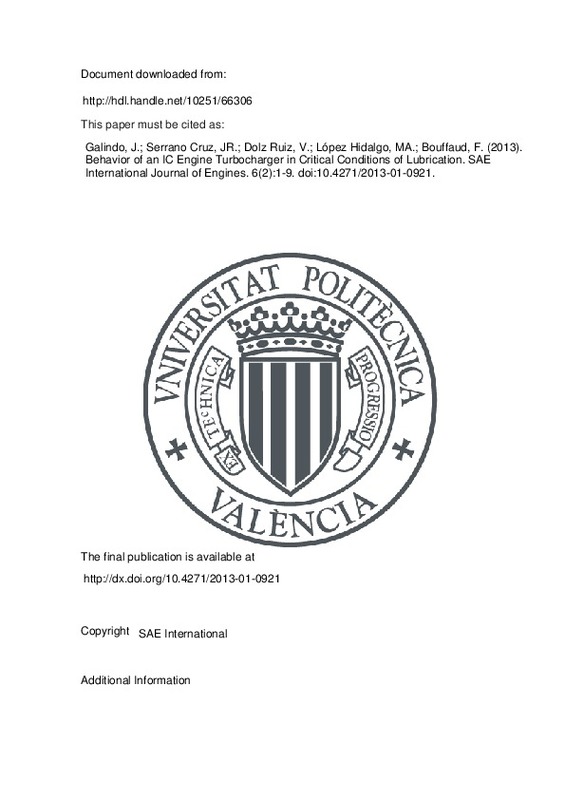JavaScript is disabled for your browser. Some features of this site may not work without it.
Buscar en RiuNet
Listar
Mi cuenta
Estadísticas
Ayuda RiuNet
Admin. UPV
Behavior of an IC Engine Turbocharger in Critical Conditions of Lubrication
Mostrar el registro sencillo del ítem
Ficheros en el ítem
| dc.contributor.author | Galindo, José
|
es_ES |
| dc.contributor.author | Serrano Cruz, José Ramón
|
es_ES |
| dc.contributor.author | Dolz Ruiz, Vicente
|
es_ES |
| dc.contributor.author | López Hidalgo, Miguel Andrés
|
es_ES |
| dc.contributor.author | Bouffaud, F.
|
es_ES |
| dc.date.accessioned | 2016-06-22T11:10:48Z | |
| dc.date.available | 2016-06-22T11:10:48Z | |
| dc.date.issued | 2013-04 | |
| dc.identifier.issn | 1946-3944 | |
| dc.identifier.uri | http://hdl.handle.net/10251/66306 | |
| dc.description.abstract | Problems in the turbocharger lubrication system can cause serious deterioration in their overall performance and even their complete destruction. The paper describes several tests with different critical lubrication conditions, in order to determine the thresholds at which the operation may be appropriate. In an IC engine, these problems can be produced mainly by several factors: the decreasing in the supply pressure of the oil, a delay in the lubrication oil pressure and an intermittent lubrication interruption. A turbocharger test bench and an IC engine test bench has been used to test the turbocharger, in order to reproduce the conditions and cycles similar to the operation of the turbocharger in an IC engine (pressures, temperatures, mass flows, accelerations, etc..). Thermodynamic variables and mechanic variables measured in the tests help to identify some of the operating limits of lubrication in critical conditions. In addition, optical techniques have been combined with accelerometer measurements, in order to detect modifications in the movement of the turbocharger shaft. The main conclusions obtained from these tests are that accelerations from low rotational speed to 100krpm, without lubrication oil in the bearing system, don’t cause significant problems in the turbocharger, for 20 sec. However, the accelerations to 150krpm can cause critical problems depending on the lubrication delay and the bearing configuration. Finally, higher acceleration rates to 200krpm, without lubrication, cause the turbocharger destruction in a few seconds. By other hand, a low oil inlet pressure given by an oil column, of about 1m in height, allows to the turbo survive during accelerations from low rotational speed to 150 krpm. | es_ES |
| dc.language | Inglés | es_ES |
| dc.publisher | SAE International | es_ES |
| dc.relation.ispartof | SAE International Journal of Engines | es_ES |
| dc.rights | Reserva de todos los derechos | es_ES |
| dc.subject.classification | INGENIERIA AEROESPACIAL | es_ES |
| dc.subject.classification | MAQUINAS Y MOTORES TERMICOS | es_ES |
| dc.title | Behavior of an IC Engine Turbocharger in Critical Conditions of Lubrication | es_ES |
| dc.type | Artículo | es_ES |
| dc.identifier.doi | 10.4271/2013-01-0921 | |
| dc.rights.accessRights | Abierto | es_ES |
| dc.contributor.affiliation | Universitat Politècnica de València. Departamento de Máquinas y Motores Térmicos - Departament de Màquines i Motors Tèrmics | es_ES |
| dc.description.bibliographicCitation | Galindo, J.; Serrano Cruz, JR.; Dolz Ruiz, V.; López Hidalgo, MA.; Bouffaud, F. (2013). Behavior of an IC Engine Turbocharger in Critical Conditions of Lubrication. SAE International Journal of Engines. 6(2):1-9. doi:10.4271/2013-01-0921 | es_ES |
| dc.description.accrualMethod | S | es_ES |
| dc.relation.publisherversion | http://dx.doi.org/10.4271/2013-01-0921 | es_ES |
| dc.description.upvformatpinicio | 1 | es_ES |
| dc.description.upvformatpfin | 9 | es_ES |
| dc.type.version | info:eu-repo/semantics/publishedVersion | es_ES |
| dc.description.volume | 6 | es_ES |
| dc.description.issue | 2 | es_ES |
| dc.relation.senia | 253411 | es_ES |







![[Cerrado]](/themes/UPV/images/candado.png)

